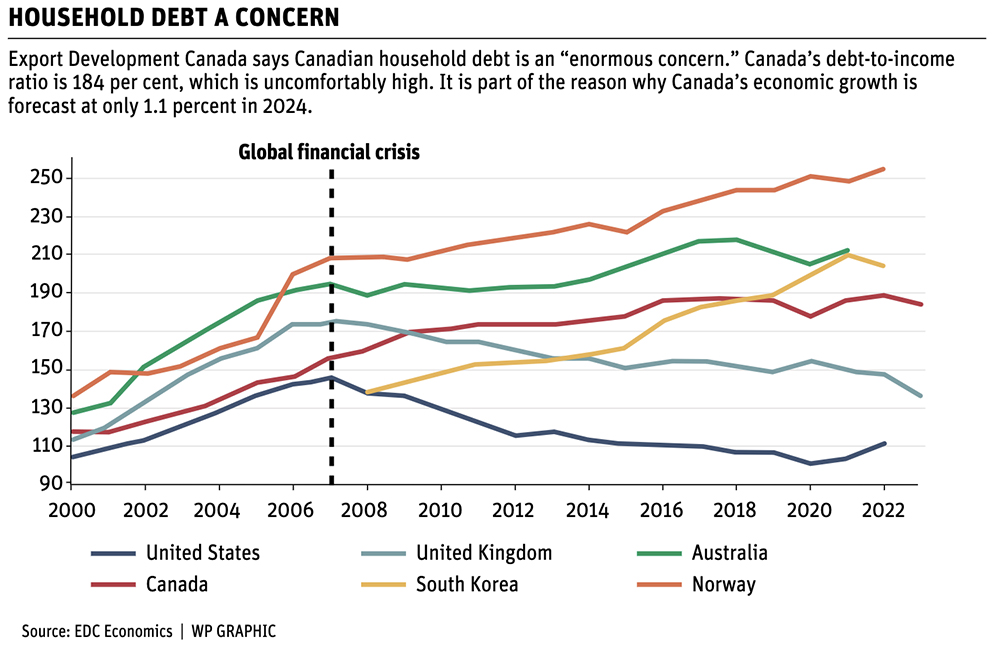Projections are better for next year, but consumer fatigue and high interest rates are dragging down economic prospects
SASKATOON — Export Development Canada just issued a ho-hum global economic outlook for 2024.
“All in all, we see a global economy that has sort of hit a soft patch,” EDC chief economist Stuart Bergman said during a recent webinar.
Related stories:
The organization is forecasting 3.1 per cent growth in world gross domestic product in 2024, slightly below last year’s lacklustre 3.2 per cent.
Read Also

Russian wheat exports start to pick up the pace
Russia has had a slow start for its 2025-26 wheat export program, but the pace is starting to pick up and that is a bearish factor for prices.
Canada’s economy will grow by 1.1 percent compared to 1.2 percent in 2023.
Things are expected to pick up in 2025 when the global economy is forecast to grow by 3.5 per cent and Canada’s accelerates by 1.9 per cent.
“It’s sort of a slow-then-grow outlook,” he said.
A myriad of factors contributed to the forecast, but there is one key driver for what Bergman termed the “whole lot of nothing” outlook.
“The global consumer appears to be running out of momentum as higher prices and interest rates have finally caught up with demand,” he said.
Consumers in the United States demonstrated incredible resilience through the pandemic years, and that’s a good thing because they are responsible for 10 US cents out of every $1 spent in the global economy.
However, there is trouble on the horizon for those important GDP catalysts.
Consumers built excess savings during the pandemic years due to government transfer payments and the lockdown-induced cap on spending.
“Restrictive interest rates have finally started to hit home, eroding those cash reserves that many of us have been relying on,” said Bergman.
The $2.16 trillion in excess savings amassed in the U.S. during the pandemic years has eroded.
Consumers in the U.S. are saving half as much as they were in the 10 years leading up to the pandemic.
It’s a different picture north of the border, where Canadian consumers still have C$351 billion worth of excess savings.
“Canadian households are actually saving more today than they were in the lead up to the pandemic,” he said.
However, there is another financial measure that keeps economists awake at night.
“Canadian household debt-to-income ratios are an enormous concern from our perspective,” said Bergman.
Canada’s ratio is 184 per cent. Canadians are spending 15 cents out of every $1 servicing debt, which is a huge drag on the economy.
The U.S. ratio is about 110 per cent by comparison because of the country’s 30-year fixed rate mortgages.
Governments around the world are not able to help kick start their economies because they’re busy repairing the carnage COVID-19 caused to their balance sheets.
“The U.S. government will spend more this year on interest payments than it will on defence,” he said.
“Think about that.”
The U.S. has the fourth highest government debt-to-GDP ratio among Organization for Economic Co-operation and Development countries, while Canada ranks sixth.
China is still dealing with its lingering property sector slowdown, while business and consumer confidence remains low.
Its economy is expected to grow by five per cent in 2024, down from 5.2 per cent last year.
That will have a negative impact on other emerging and frontier markets, such as many Association of Southeast Asian Nations countries that are reliant on China for trade and investment.
Bergman said geopolitics has the potential to upend the EDC’s economic outlook. The war in Ukraine, rising tensions between the U.S. and China and the growing conflict in the Middle East are a few examples of simmering risks.
So far, the economic effects of such geopolitical disturbances have been largely contained, but there is potential for major disruption and growing isolationism.
















